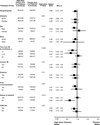Oral high-dose multivitamins and minerals after myocardial infarction: a randomized trial
- PMID: 24490264
- PMCID: PMC4143134
- DOI: 10.7326/0003-4819-159-12-201312170-00004
Oral high-dose multivitamins and minerals after myocardial infarction: a randomized trial
Abstract
Background: Whether high-dose multivitamins are effective for secondary prevention of atherosclerotic disease is unknown.
Objective: To assess whether oral multivitamins reduce cardiovascular events and are safe.
Design: Double-blind, placebo-controlled, 2 x 2 factorial, multicenter, randomized trial. (ClinicalTrials.gov: NCT00044213) SETTING: 134 U.S. and Canadian academic and clinical sites.
Patients: 1708 patients aged 50 years or older who had myocardial infarction (MI) at least 6 weeks earlier and had serum creatinine levels of 176.8 mol/L (2.0 mg/dL) or less.
Intervention: Patients were randomly assigned to an oral, 28-component, high-dose multivitamin and multimineral mixture or placebo.
Measurements: The primary end point was time to total death, recurrent MI, stroke, coronary revascularization, or hospitalization for angina.
Results: The median age was 65 years, and 18% of patients were women. The qualifying MI occurred a median of 4.6 years (interquartile range [IQR], 1.6 to 9.2 years) before enrollment. Median follow-up was 55 months (IQR, 26 to 60 months). Patients received vitamins for a median of 31 months (IQR, 13 to 59 months) in the vitamin group and 35 months (IQR, 13 to 60 months) in the placebo group (P = 0.65). Totals of 645 (76%) and 646 (76%) patients in the vitamin and placebo groups, respectively, completed at least 1 year of oral therapy (P = 0.98), and 400 (47%) and 426 (50%) patients, respectively, completed at least 3 years (P = 0.23). Totals of 394 (46%) and 390 (46%) patients in the vitamin and placebo groups, respectively, discontinued the vitamin regimen (P = 0.67), and 17% of patients withdrew from the study. The primary end point occurred in 230 (27%) patients in the vitamin group and 253 (30%) in the placebo group (hazard ratio, 0.89 [95% CI, 0.75 to 1.07]; P = 0.21). No evidence suggested harm from vitamin therapy in any category of adverse events.
Limitation: There was considerable nonadherence and withdrawal, limiting the ability to draw firm conclusions (particularly about safety).
Conclusion: High-dose oral multivitamins and multiminerals did not statistically significantly reduce cardiovascular events in patients after MI who received standard medications. However, this conclusion is tempered by the nonadherence rate.
Primary funding source: National Institutes of Health.
Figures
Comment in
-
Enough is enough: Stop wasting money on vitamin and mineral supplements.Ann Intern Med. 2013 Dec 17;159(12):850-1. doi: 10.7326/0003-4819-159-12-201312170-00011. Ann Intern Med. 2013. PMID: 24490268 No abstract available.
-
ACP Journal Club. High-dose oral multivitamins and minerals after MI did not reduce CV events.Ann Intern Med. 2014 May 20;160(10):JC4. doi: 10.7326/0003-4819-160-10-201405200-02004. Ann Intern Med. 2014. PMID: 24842438 No abstract available.
Summary for patients in
-
Summaries for patients. High-dose multivitamins and minerals after a heart attack.Ann Intern Med. 2013 Dec 17;159(12):I-20. doi: 10.7326/0003-4819-159-12-201312170-00001. Ann Intern Med. 2013. PMID: 24490272 No abstract available.
References
-
- Stanner SA, Hughes J, Kelly CN, Buttriss J. A review of the epidemiological evidence for the 'antioxidant hypothesis'. Public Health Nutr. 2004;7:407–422. - PubMed
-
- Vivekananthan DP, Penn MS, Sapp SK, Hsu A, Topol EJ. Use of antioxidant vitamins for the prevention of cardiovascular disease: meta-analysis of randomised trials. Lancet. 2003;361:2017–2023. - PubMed
-
- Bjelakovic G, Nikolova D, Gluud LL, Simonetti RG, Gluud C. Mortality in randomized trials of antioxidant supplements for primary and secondary prevention: Systematic review and meta-analysis. JAMA. 2007;297:842–857. - PubMed
Publication types
MeSH terms
Substances
Associated data
Grants and funding
LinkOut - more resources
Full Text Sources
Other Literature Sources
Medical



